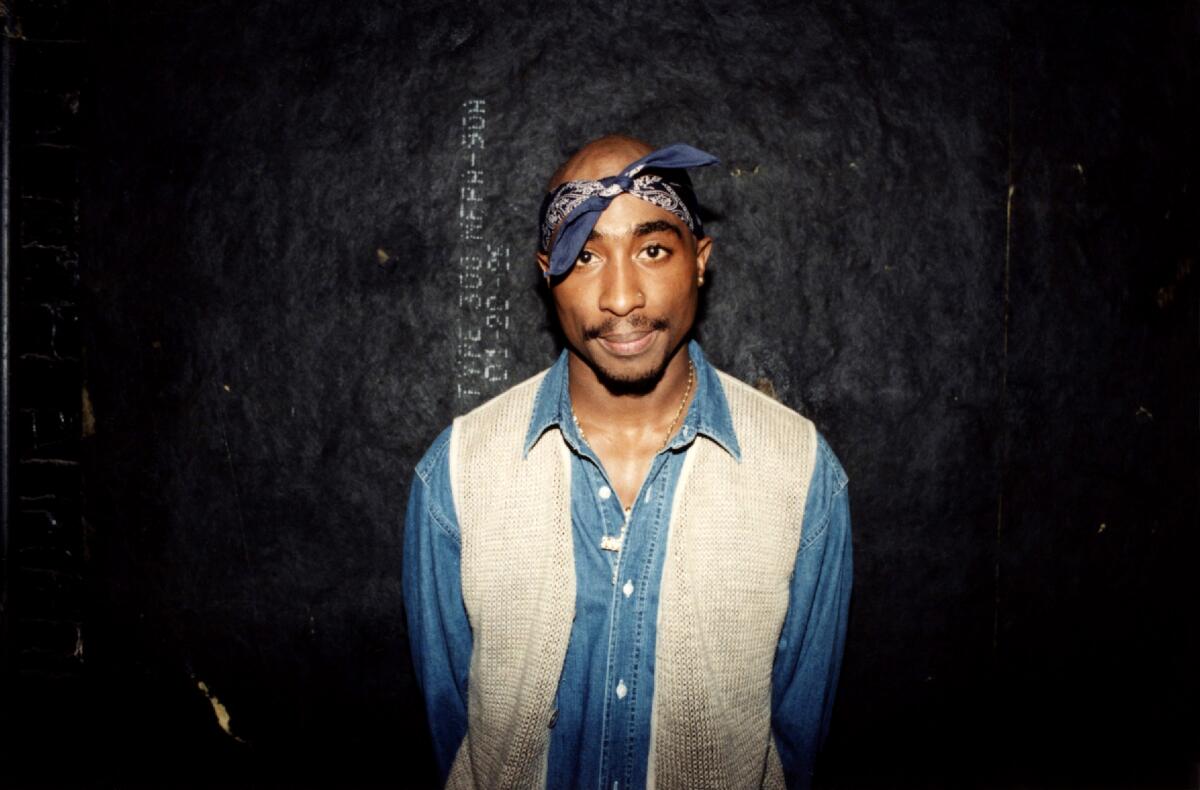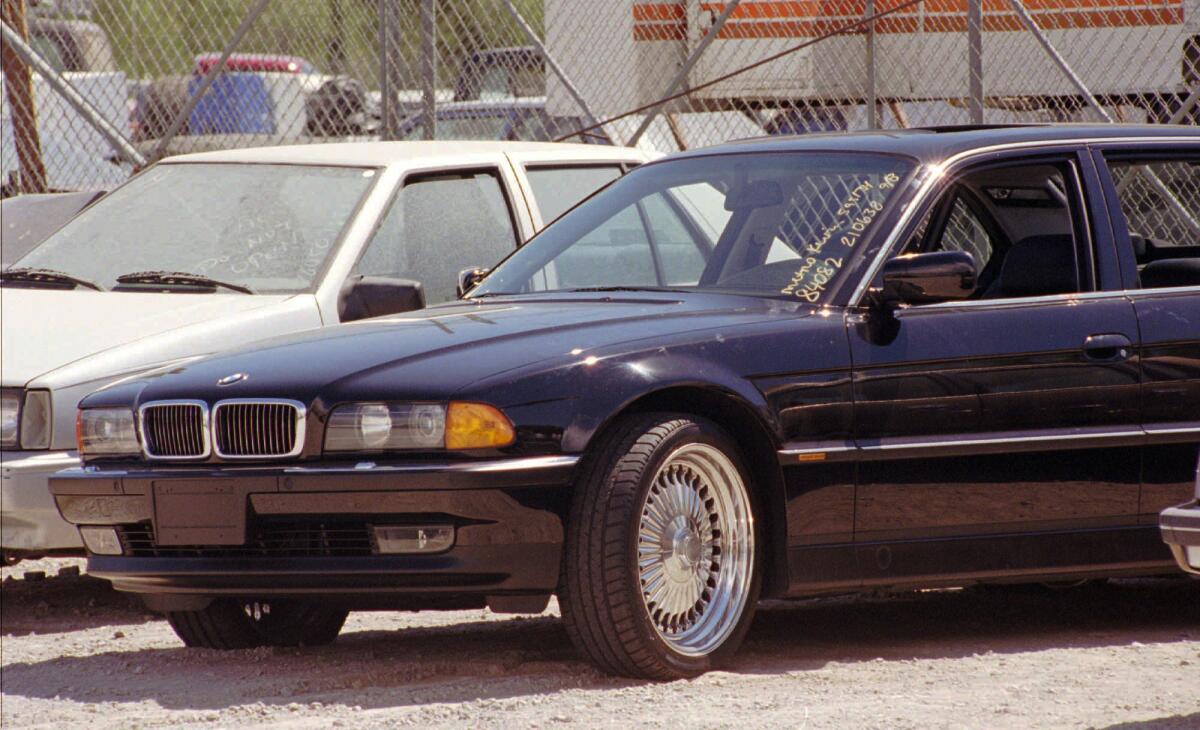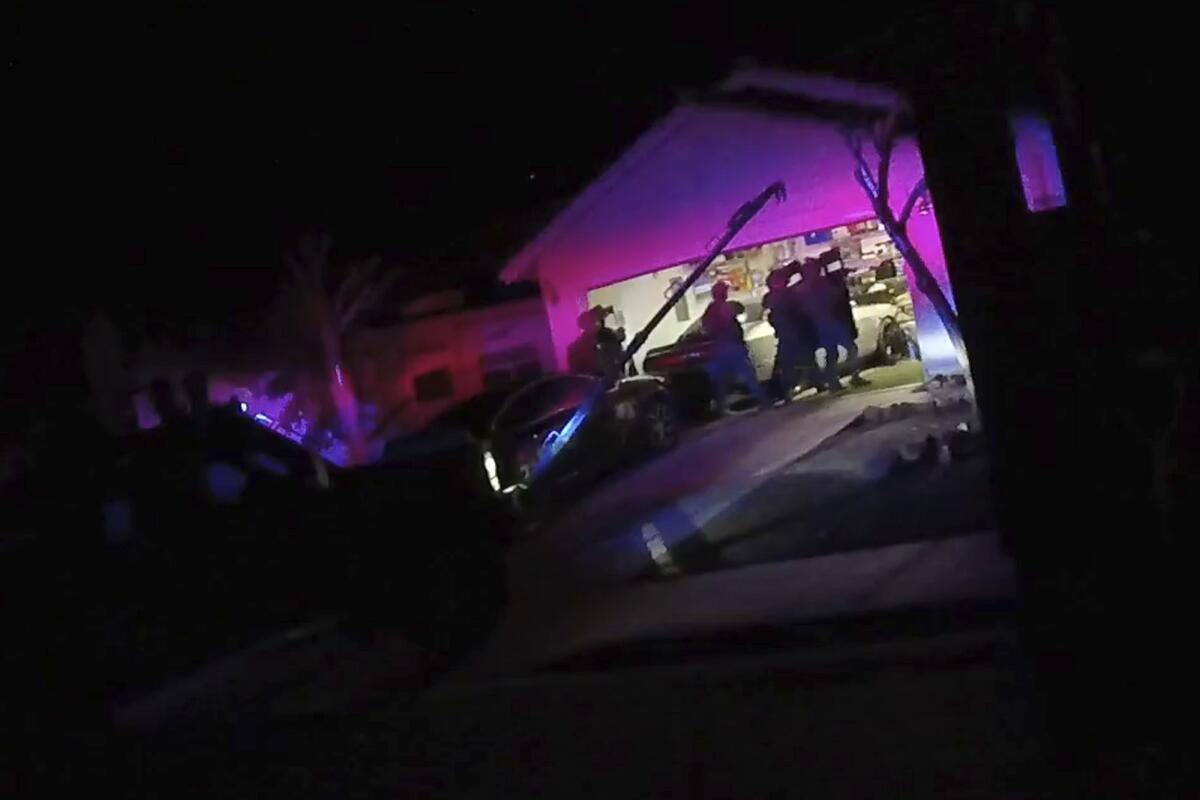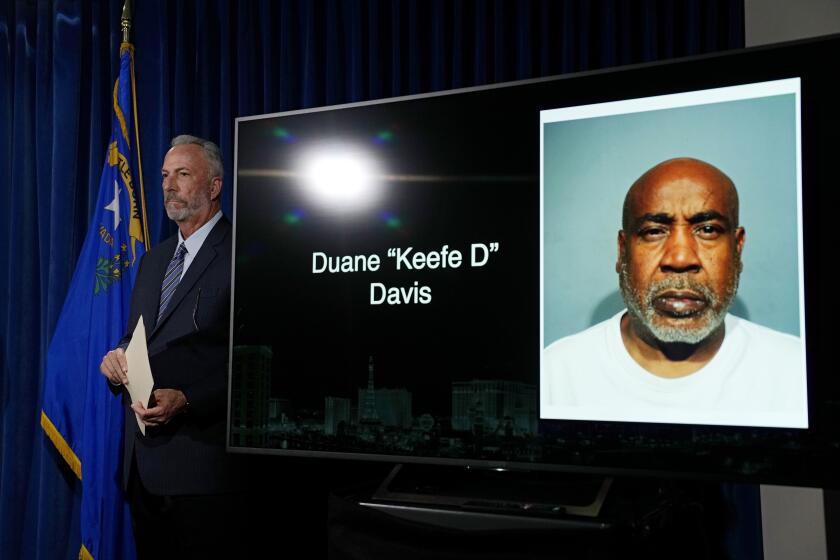Suspect charged with murder in 1996 killing of rapper Tupac Shakur

- Share via
A man who has long acknowledged he was in the car that pulled alongside Tupac Shakur on the night the rapper was gunned down in Las Vegas was charged Friday with murder, with prosecutors saying he orchestrated the 1996 shooting.
Duane “Keffe D” Davis, 60, was taken into custody early Friday, authorities said. He was indicted on a charge of murder with the use of a deadly weapon with an enhancement of intent to preserve or assist a criminal gang.
The charge marks a milestone in the nearly three-decade hunt for the killer of the famed rapper, a case that produced a cottage industry of speculation as well as questions about why authorities could not solve the slaying.
“I know a lot of people have been waiting for this day,” Clark County, Nev., Dist. Atty. Steve Wolfson said during a news conference Friday.
Shakur’s stepbrother, Mopreme Shakur, said he was cautiously optimistic about the news of Davis’ arrest.
“We still have to find out about accomplices — if there are any — and you still have to find out about motive, you know. And it’s all sad because it didn’t have to be this way,” he said when reached by phone Friday. “It’s f— up and a reminder that my brother still ain’t here, but it’s nice to have some accountability.”
Wolfson said a grand jury had been seated for months to help bring new charges in the case.
Tupac Shakur was gunned down while riding in a BMW driven by Marion “Suge” Knight. Knight, then-owner of Shakur’s record label, Death Row Records, was leading a procession of luxury vehicles past the MGM Grand Hotel and Caesars Palace on their way to a new nightclub.

It was after 11 p.m. that Saturday when the BMW stopped at Flamingo Road and Koval Lane, a block from the Las Vegas Strip, authorities said. Shakur was flirting with women in a nearby car, unaware that a white Cadillac had pulled alongside the BMW. A gunman inside the Cadillac reached out and pointed a semiautomatic pistol straight at Shakur, according to police and court records.
Four bullets struck Shakur and another grazed Knight, authorities said. Shakur died from his injuries six days later on Sept. 13. He was 25.
When asked about his last conversation with his stepbrother, Mopreme Shakur said it was in the hospital room, but no words were exchanged.
“He couldn’t communicate with me. He had tubes all around him. He was talking to me with his eyes, but I couldn’t figure out what he was saying,” he said. “And now that haunts me to this day.”
Before Tupac Shakur died, the Rev. Jesse Jackson prayed at his bedside with Shakur’s mother, Afeni Shakur.
“This is so, so sad,” Jackson said at the time. “Sometimes the lure of violent culture is so magnetic that even when one overcomes it with material success, it continues to call. He couldn’t break the cycle.”
Despite numerous investigations by Las Vegas and Los Angeles police as well as federal law enforcement agencies, no one had been arrested in the killing.
Vegas police investigating Tupac Shakur’s slaying seized bullet cartridges, computers and photos from the home of a gang member who was in the shooter’s car.
Davis, who has no listed attorney of record, had previously described his activities in the South Side Compton Crips gang and said he was inside the white Cadillac from which Shakur’s killer fired.
In his book, “Compton Street Legend,” Davis detailed those experiences and said he hid the Cadillac and gun after the shooting and had the vehicle repaired and repainted before returning it to a rental car company.
He also said he is the uncle of Orlando Anderson, another Crips member who also was in the Cadillac along with two other men — Terrence Brown and DeAndre Smith. Anderson was killed in a gang shootout in Compton a year and a half after Shakur’s death. Brown was found shot to death in Compton in September 2015. Smith also has since died.
Las Vegas police previously investigated Anderson in connection with Shakur’s slaying. He was identified as having been involved in a physical altercation with Knight, Shakur and his bodyguards on the night of the fatal shooting.
Like Davis, Anderson was a member of the South Side Compton Crips, authorities said. Shakur and Knight were affiliated with a rival Compton gang, the Mob Piru Bloods; Shakur’s bodyguards were also members of the Bloods.
In his 2019 memoir and in several interviews, Davis admitted to riding in the car from which the fatal shots were fired at the Los Angeles hip-hop legend. Davis was taken into custody Friday morning.
In detailing the charge against Davis, Chief Deputy Dist. Atty. Marc DiGiacomo pointed out his self-described gang ties to the Crips as well as the association of Shakur and Knight to the rival Bloods.
“The Mob Piru were in competition ... with another gang by the name of South Side Compton Crips,” DiGiacomo said. “By mid-1996, there wasn’t much of a distinction between Mob Piru and Death Row Records,” Knight’s record label, he said.
The night of the shooting, members of the rival gangs attended a Mike Tyson boxing match at the MGM Grand. Afterward, Travon “Tray” Lane, a Mob Piru gang member, spotted Anderson in the elevator and recognized him as one of several rival gang members who had tried to steal a Death Row necklace from him during an earlier brawl.
Lane alerted Shakur, who then attacked Anderson and there was “a giant beat-down of Mr. Anderson,” the prosecutor said.
For the record:
3:43 p.m. Sept. 29, 2023An earlier version of this article attributed a quote about an altercation leading to the attack on Tupac Shakur to Las Vegas Metropolitan Sheriff Kevin McMahill. The quote was from Las Vegas Metropolitan homicide Lt. Jason Johansson.
“Little did anyone know that it was this incident right here that would lead to the retaliatory shooting and death of Tupac Shakur,” Las Vegas Metropolitan homicide Lt. Jason Johansson said at the news conference Friday.
After learning of the attack, Davis “formulated a plan to exact revenge upon Mr. Knight and Mr. Shakur, and in furtherance of that, he acquired a .40-caliber Glock firearm from a drug associate he had,” DiGiacomo told the court in announcing the murder charges.
Prosecutors allege that Davis and other Crips members drove in two vehicles to Club 662, where Shakur was supposed to attend a concert. When the rapper did not show up, Davis and the others went to a liquor store, where Davis got out of a van and into the Cadillac.
“‘I don’t want to be in the van anymore because these individuals aren’t down with what I want to do: Go shoot Tupac Shakur and Marion ‘Suge’ Knight,’” the prosecutor recounted Davis as saying.
When Davis got in the Cadillac, he handed the Glock to two individuals in the back seat, DiGiacomo said, noting that Brown was driving, while Anderson and Smith were also in the car.
As they drove west on Flamingo, they spotted the caravan with Knight and Shakur. “There was an order for them to do a U-turn,” DiGiacomo said. “They pulled up next to the vehicle as the rear passenger fired a number of rounds out of that vehicle, striking Knight and Shakur in the head several times.”
Knight was sentenced to prison in 1997 for a probation violation stemming from the beat-down of Anderson. The four gang members who participated in the Las Vegas beating were Alton McDonald, Lane, Roger “Neckbone” Williams and Aaron “Heron” Palmer. Of these, Lane was sent to prison for his role in a drive-by shooting; Williams was jailed on a weapons violation; Palmer was killed in a drive-by shooting in June 1997; and McDonald was gunned down April 3, 2002, while filling his SUV with gas.

Police put renewed interest in Shakur’s slaying in recent months. They searched Davis’ home in Henderson, Nev., in July using a warrant that allowed them to seize materials they said were connected to the shooting.
Among the evidence seized were .40-caliber cartridges, computers, photos and other materials, records show. The judge also authorized investigators to seize any items that could tie Davis to the South Side Compton Crips, according to the warrant approved by Clark County Judge Jacqueline M. Bluth.
Las Vegas Metropolitan Sheriff Kevin McMahill said that while detectives have had plenty of evidence in the case, Davis’ own admissions gave new life to the investigation in the last five years. “We knew at this time that this was likely the last time to take a run at this case to successfully solve this,” he said.
Prosecutors asked no bail be set for Davis, noting that since 2018, he has been making public statements about his involvement in the shooting. In his 2019 book, Davis detailed how he was the “shot caller” of the South Side Compton Crips, “or as he put it, ‘We were in the Army. I was the five-star general,’” DiGiacomo said, noting that Davis was the “on-ground, on-site commander” who “ordered the death” of Shakur.
Nevada does not have a statute of limitations for prosecuting homicide cases. Wolfson said that under state law, Davis did not have to pull the trigger to be charged with murder with a deadly weapon.
The district attorney used Shakur’s own words to sum up the events that led to Friday’s charges: “Tupac was actually quoted saying, ‘Death is not the greatest loss in life; the greatest loss is what dies inside while still alive. Never surrender.’”
“Well, we didn’t surrender,” he said.
More to Read
Sign up for Essential California
The most important California stories and recommendations in your inbox every morning.
You may occasionally receive promotional content from the Los Angeles Times.














